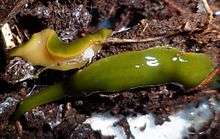Reproductive system of planarians

The reproductive system of planarians is considerably regular among different families, although the structures associated can be more or less complex.
All planarians are hermaphrodites, so their reproductive system has a male and a female part. Both parts communicate with the surface of the body via a single opening called gonopore, which is located on the ventral side of the posterior half of the body.
Male part of the reproductive system

The male part of the reproductive system in planarians has a set of several testicles, distributed throughout the body in two or more rows. They are usually concentrated in the anterior two thirds of the body, although they can reach close to the posterior end. The testicles are connected to a pair of sperm ducts which run posteriorly towards the gonopore.
In some groups, the sperm ducts met in their distal part, forming the ejaculatory duct, which then opens in a cavity called “male atrium”. In others, like land planarians, both open in the prostatic vesicle, a glandular organ which then runs posteriorly and becomes the ejaculatory duct. The male atrium is located anteriorly to the gonopore.
Usually associated to the ejaculatory duct, there is a structure formed basically by a fold of the walls of the male atrium called “penis papilla”. The penis papilla may be a permanent structure, which occupies part or the whole male atrium, or a temporary one. A temporary penis papilla is formed only during copulation by a projection of the walls in the male atrium.[1]
Female part of the reproductive system

The female part of the reproductive system in planarians is formed by two ovaries in the anterior region. Exiting the ovaries, a pair of oviducts (or, more precisely, ovovitelloducts) runs posteriorly towards the gonopore. A group of yolk glands also connects to these ducts, as planarians are neoophorans and thus yolk is not located inside the eggs.
Close to the gonopore, the ovovitelloducts reach a cavity called “female atrium”, which is located posteriorly to the gonopore. The ovovitelloducts may or not meet and become a single duct (common ovovitelloduct) before entering the female atrium. The distal part of the ovovitelloducts is usually sorrrounded by shell glands, which secrete the material that forms the shell of the eggcase (also called cocoon).[2]
Accessory structures

Among the accessory structures of the reproductive system of planarians, one usually found in freshwater and marine species is the bursa copulatrix, which has the function to store sperm after mating.[3] Some land planarians has a series of finger-like projections, called adenodactyls, near the male and female atria. Adenodactyls contain glands and produce several secretions believed to be useful during reproduction.[4]
References
- ↑ Ogren, R. E. and Kawakatsu, M. (1990). Index to the specis of the family Geoplanidae (Turbellaria, Tricladida, Terricola) Part I: Geoplaninae. Bulletin of Fujis Women's College. 29: 79-166.
- ↑ Sluys, R.; Kawakatsu, M.; Winsor, L. (1998). "The genus Dugesia in Australia, with its phylogenetic analysis and historical biogeography (Platyhelminthes, Tricladida, Dugesiidae)". Zoologica Scripta 27 (4): 273. doi:10.1111/j.1463-6409.1998.tb00461.x.
- ↑ Kaburaki, T. (1922). One some Japanese Tricladida Maricola, with a Note on the Classification of the Group. Journal of the College of Science, Tokyo Imperial University. 54: 1-54.
- ↑ Graff, L. v. (1896). Über die Morphologie des Geschlechtesapparates der Landplanarien. Verhandlungen der Deutschen Zoologische Gesellschaft: 75-93.
| ||||||||||||||||||||||||||||||||||||||||||||||||||||||||||||||